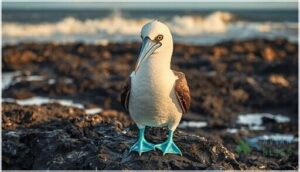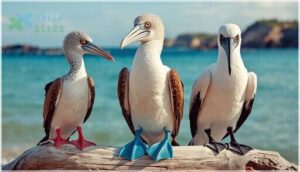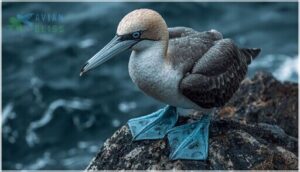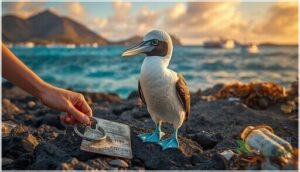This site is supported by our readers. We may earn a commission, at no cost to you, if you purchase through links.
The Spanish sailors who first spotted these clumsy seabirds bobbing on tropical waves weren’t being cruel—they were being honest. “Bobo,” they called them, Spanish slang for stupid, and the name stuck for over four centuries. Boobies, those striking plunge-diving seabirds of the Sulidae family, earned their unfortunate moniker by landing fearlessly on ship decks, where hungry sailors made easy work of them.
But don’t let the name fool you. These birds have survived in some of the planet’s harshest marine environments through impressive adaptations—vibrant blue feet that signal mate quality, precision beaks built for piercing water at terminal velocity, and hunting strategies that would make any fisherman envious.
Six species patrol tropical and subtropical waters today, from the Galápagos to the Red Sea, each displaying notable behaviors that reveal just how clever these supposedly “stupid” birds actually are.
Table Of Contents
- Key Takeaways
- What Are Boobies?
- Booby Species and Physical Traits
- Booby Habitat and Global Distribution
- Booby Behavior and Life Cycle
- Conservation Status and Human Interaction
- Frequently Asked Questions (FAQs)
- Do boobies mate for life?
- Do boobies like to face a specific direction?
- Why do boobies eat ships?
- What is the meaning of booby?
- How many eggs does a Boobie have?
- Why do boobies eat bigger than males?
- Is it booby or boobies?
- When did breasts start being called boobies?
- What does hard boobies mean?
- What does “boobies” mean in slang?
- Conclusion
Key Takeaways
- Despite their name (from Spanish “bobo” meaning foolish), boobies are highly adapted seabirds with specialized hunting skills like plunge-diving from 30 meters at 97 km/h and vibrant blue feet that signal mate quality during courtship displays.
- Six booby species inhabit tropical and subtropical waters worldwide, with the Galápagos Islands serving as the most critical breeding ground—hosting roughly half of all blue-footed booby nesting pairs, though populations have crashed from over 20,000 in the 1960s to around 6,000 today.
- Boobies employ impressive parental strategies including biparental incubation lasting 41-45 days and up to six months of chick rearing, though intense sibling rivalry typically results in only one offspring surviving per nest.
- While most booby species hold “Least Concern” conservation status, they face mounting threats from climate change disrupting prey availability, fisheries competition, invasive species at nesting sites, and marine pollution—with Abbott’s booby classified as Endangered.
What Are Boobies?
If you’ve ever heard the term “boobies” and wondered what all the fuss is about, you’re not alone. These charismatic seabirds have captured attention for centuries, though their quirky name often leads to a few raised eyebrows and plenty of confusion.
Let’s clear up what boobies actually are, where they fit in the bird world, and why they’re worth knowing about.
Definition and Etymology
You might chuckle at the name, but boobies are actually large tropical seabirds in the family Sulidae. The term “booby” comes from Spanish slang “bobo,” meaning stupid, dating back to the 1590s. Spanish sailors gave them this name because these avian species would land on ships and were easily captured.
Boobies, large tropical seabirds, earned their amusing name from Spanish sailors who found them foolishly easy to catch aboard ships
The genus Sula was established in 1760, with six extant booby species recognized today. These birds are known for their surprise plunge attacks when hunting.
Boobies in Bird Taxonomy
If you’re curious about where boobies fit in the bird world, you’ll find them in the family Sulidae—a taxonomic group that includes both boobies and their close cousins, the gannets. Within Sulidae phylogeny, all six widely recognized booby species belong to the genus Sula, a classification supported by both genetic data and physical traits.
Modern avian taxonomy now places Sulidae in the order Suliformes, reflecting updated evolutionary relationships of birds. These birds are known for their plunge-diving behavior to catch fish.
Common Misconceptions
Despite their place in Suliformes, several misunderstandings still cloud how you might perceive booby bird species. Here’s what often trips people up:
- Name origins – The term “booby” comes from Spanish “bobo” (foolish), referencing their tameness on land, not actual lack of intelligence in flight or seabird characteristics.
- Foot coloration – Blue feet signal diet quality, not genetics.
- Habitat range – They’re not Galápagos-only; many species span tropical oceans worldwide.
Booby Species and Physical Traits
When you think of boobies, three main species stand out: the blue-footed, red-footed, and brown booby. Each one has its own look, from vibrant foot colors to distinct plumage patterns that help you tell them apart in the wild.
Let’s take a closer look at what makes each species unique and how their physical traits set them apart.
Blue-footed Booby
You’ll recognize the blue-footed booby by its vibrant turquoise feet—a feature that plays a starring role in mating rituals. Males flaunt their foot coloration in elaborate courtship dances to attract mates on rocky shores of the Galapagos Islands and along Pacific coasts.
Sardine scarcity has created conservation challenges, causing population declines despite this seabird’s adaptability and fascinating behavior patterns that captivate researchers and birdwatchers alike.
Red-footed Booby
The red-footed booby (Sula sula) is the smallest member of its family, weighing just 800–1,000 grams with a 137 cm wingspan. You’ll notice plumage polymorphism across white, brown, and intermediate morphs—all sporting those signature crimson feet.
These seabirds travel hundreds of kilometers on foraging distances from breeding colonies at Aldabra and throughout tropical oceans. Dietary variation shifts seasonally; squid comprises 21% of meals during wet seasons but drops to 1% in dry periods.
Despite conservation challenges from climate shifts and fishery competition, their global population remains stable at roughly 1.4 million individuals.
Brown Booby
The Brown Booby (Sula leucogaster) is a pantropical seabird spanning the Atlantic, Pacific, Indian, and Red Sea, with over 200,000 individuals worldwide. You’ll find this resilient bird species mastering coastal life through three key adaptations:
- Nesting Substrates: Prefers flat coral atolls and volcanic islands
- Foraging Ecology: Hunts within 111 km, targeting shelf-edge fish
- Population Trends: Demographically stable despite marine debris threats
Size, Color, and Distinctive Features
Across booby species, you’ll notice plumage variation reflecting both maturity and sexual dimorphism. Blue-footed Boobies span 81–90 cm with brown-and-white contrast, while Red-footed Boobies display three morphs and reach 69–79 cm. The Masked Booby, largest at 85 cm, shows striking white plumage with a black facial mask.
Juveniles generally start with white down changing to grayish-brown, marking distinct developmental stages in these tropical birds.
Beak and Foot Characteristics
When you watch a blue-footed booby dive from 30 meters at 97 km/h, you’re seeing bill morphology perfected for piercing water. Their long, sharply pointed beaks act as spears, while webbed feet—connecting all four toes—power underwater pursuit.
Foot coloration matters too: vivid blue signals diet quality during courtship. For thermal regulation and bird identification, those vascularized feet double as incubation tools, transferring heat directly to eggs.
Booby Habitat and Global Distribution
Boobies aren’t picky about where they live, but they do stick to certain parts of the world. You’ll find these seabirds scattered across tropical and subtropical regions, mainly hanging out near coastlines and islands where the fishing’s good.
Let’s look at where different booby species make their homes and why these spots work so well for them.
Geographic Range
You’ll find boobies spread across all three major oceans—Pacific, Atlantic, and Indian—primarily between 30°N and 30°S latitude.
The Galápagos Islands host about half of all blue-footed booby breeding pairs, making it essential for the species.
Brown boobies show the widest oceanic distribution, while vagrant sightings occasionally pop up as far north as Canada, proving these seabirds don’t always respect range limits.
Tropical Islands and Coastal Regions
You’ll encounter boobies nesting on isolated tropical islands where coastal cliffs, beaches, and low vegetation meet productive ocean foraging zones. Red-footed boobies breed colonially across Indian Ocean atolls like Aldabra—where over 22,000 active nests were counted—while brown boobies claim Caribbean cays and shoreline bluffs.
Human impacts from tourism and recreation increasingly disturb these coastal colonies, particularly along popular tropical beaches where breeding birds gather.
Notable Habitats (e.g., Galápagos Islands)
The Galápagos stands out as the world’s most important breeding center for blue-footed boobies—roughly half of all nesting pairs raise chicks here. This island ecosystem bolsters around 6,000 individuals within the sprawling Galápagos Marine Reserve, where legal protections buffer booby habitat and distribution from industrial fishing.
You’ll also find major Nazca booby colonies across the archipelago, linking bird distribution throughout the tropical eastern Pacific to this protected marine life hotspot.
Booby Behavior and Life Cycle
Boobies aren’t just colorful—they’re some of the most entertaining seabirds you’ll ever watch. From their goofy courtship dances to their high-speed fishing dives, these birds know how to put on a show.
Here’s what you need to know about how boobies live, breed, and raise their young.
Mating and Courtship Displays
You’ll witness striking mating displays when boobies advertise their readiness to breed. Blue-footed males lift their vibrant feet alternately up to 20 times per display sequence, allowing females to assess male health via foot hue brightness.
Brown booby males execute sky-pointing with necks fully extended, accompanied by unique whistling calls.
Red-footed boobies demonstrate considerable mating flexibility, with courtship acts repeating every 15 months based on food availability and territory defense needs.
Nesting and Breeding Habits
Once boobies pair up, nesting begins—often on bare ground or in trees, depending on species. Brown boobies lay 1–3 pale bluish eggs in simple scrapes, while red-footed boobies prefer bushes.
Incubation periods stretch 42–45 days, with both parents warming eggs under their feet. Chick rearing demands up to five months of parental care, though sibling rivalry means only one offspring usually survives.
Feeding and Hunting Strategies
Feeding chicks demands intensive foraging trips. You’ll spot boobies plunge-diving from heights of 4–8 m, targeting fish and squid with dramatic headfirst splashes. Blue-footed boobies average nearly 17 dives per hour, reaching depths around 22 m.
Sexual size dimorphism shapes hunting: larger females and smaller males often exploit different prey sizes. Diet composition varies—Pacific anchoveta and thread herring fuel breeding success, while red-footed boobies prefer flying squid.
Parental Care
From nest-building to fledging, both booby parents share the load. Biparental incubation lasts around 41 days for a blue-footed booby clutch size of two eggs, followed by chick rearing that stretches up to six months. Parental investment includes constant feeding and nest defense, yet sibling competition runs fierce—larger chicks monopolize meals.
You’ll notice this bird behavior pattern across breeding sites, where the bird incubation process shapes survival odds.
Conservation Status and Human Interaction
Boobies aren’t facing the same crisis as some seabirds, but they’re not completely in the clear either. Human activity—both helpful and harmful—plays a big role in their survival.
Let’s look at where these birds stand today and how we interact with them.
Current Conservation Status
Most booby species hold Least Concern status according to IUCN classifications, but you’ll find concerning variations beneath that label. Abbott’s booby stands apart as Endangered, confined to a single breeding colony on Christmas Island.
Blue-footed booby populations crashed from over 20,000 individuals in the 1960s to roughly 6,000 today, while brown boobies number 90% fewer than a century ago—sobering breeding estimates that reveal colony vulnerabilities worldwide.
Threats to Booby Populations
From rising sea temperatures to vanishing prey, you’re witnessing threats that push boobies toward decline across ocean basins. Climate change disrupts upwelling zones essential for feeding, while fisheries impact their survival through direct competition for anchovy and sardine stocks.
Four critical pressures shape demographic shifts today:
- Invasive species preying on eggs and chicks at nesting sites
- Marine pollution from plastics and oil spills
- Habitat degradation altering bird habitat quality
- Storm events causing breeding failures
Ecotourism and Wildlife Photography
You’ll find blue-footed booby colonies at the heart of Galápagos ecotourism, where ethical photography guidelines protect nesting bird habitats while delivering economic benefits to local communities.
Tourist impact remains low when you follow regulated trails and distance rules, turning wildlife photography into conservation messaging that funds habitat preservation.
Nature-focused tours balance your close encounters with the strict codes that keep these charismatic seabirds thriving.
Conservation Efforts and Research
Protecting these plunge-diving specialists demands action across ocean and island. Conservation efforts are tackling three key fronts:
- Habitat protection through marine reserves and island refuges safeguarding critical breeding colonies
- Bycatch reduction via gillnet modifications and fishing restrictions near nesting sites
- Population monitoring tracking breeding success and climate impacts on prey availability
Policy responses now link fisheries management with booby behavior and breeding patterns, recognizing that marine bird adaptations require intact food webs across their evolutionary relationships with tropical ecosystems.
Frequently Asked Questions (FAQs)
Do boobies mate for life?
You might think seabirds stick together forever, but most blue-footed boobies don’t pair for life. About half of bonded pairs divorce each year, cycling through multiple partners across their breeding careers.
Do boobies like to face a specific direction?
Regarding “heading” in the right direction, boobies don’t stick to one compass bearing. Their flight direction, nest orientation, and homing orientation flexibly shift with wind, sun angle, colony structure, and environmental responses—pure seabird behavior pragmatism.
Why do boobies eat ships?
Boobies don’t actually eat ships—they follow vessels to catch flying fish stirred up by the wake.
This ship-following behavior lets them exploit discard food and light attraction at night, though bycatch risks increase with habitat changes.
What is the meaning of booby?
The term traces back to Spanish slang “bobo,” meaning foolish—sailors watched these trusting seabirds land aboard ships, easily caught. Later, “booby” gained unrelated slang meanings for anatomy.
How many eggs does a Boobie have?
You’ll find most boobies lay one to three eggs per clutch, with blue-footed species generally producing two.
Incubation period spans roughly 42 days, though parental investment often results in just one fledgling success per breeding colonies.
Why do boobies eat bigger than males?
In many bird species, size dimorphism drives foraging behavior differences. Female boobies, being 30% heavier, dive deeper and target larger prey—offsetting higher energetic demands while reducing niche partitioning competition with smaller males.
Is it booby or boobies?
In avian taxonomy, you’ll use “booby” for one bird—like a single blue-footed booby (S. nebouxii)—and “boobies” for multiple individuals. Grammatical correctness follows standard singular vs. plural rules across anatomical usage and bird terminology throughout historical context.
When did breasts start being called boobies?
Boobies” emerged in U.S. slang by 1916, evolving from the 17th-century term “bubby.”
This historical evolution reflects cultural influence on breast terminology, with scholarly consensus tracing the shift from bubby origins through booby to modern “boobs” by
What does hard boobies mean?
In medical terms, breast firmness can signal anything from benign cysts to urgent malignancies.
You’ll want prompt evaluation if a hard, painless lump persists—especially with skin changes or nipple discharge.
What does “boobies” mean in slang?
In casual conversation, this term informally refers to a woman’s breasts. You’ll hear it used playfully rather than clinically—like “boobs” but slightly more childish. It emerged in American English around the early twentieth century.
Conclusion
Those Spanish sailors who named boobies centuries ago couldn’t have known they were watching evolutionary masterpieces in action.
You’ve now seen past the unfortunate label to discover birds that thrive through specialized hunting techniques, elaborate courtship rituals, and remarkable adaptations.
Whether you’re planning a Galápagos expedition or simply appreciating these seabirds from afar, you understand what makes them truly special—proof that first impressions don’t tell the whole story.
- https://pmc.ncbi.nlm.nih.gov/articles/PMC3081868/
- https://www.cdc.gov/united-states-cancer-statistics/publications/breast-cancer-stat-bite.html
- https://seer.cancer.gov/statfacts/html/breast.html
- https://www.bcrf.org/breast-cancer-statistics-and-resources/
- https://www.clinicaladvisor.com/features/breast-cancer-statistics-2023/












